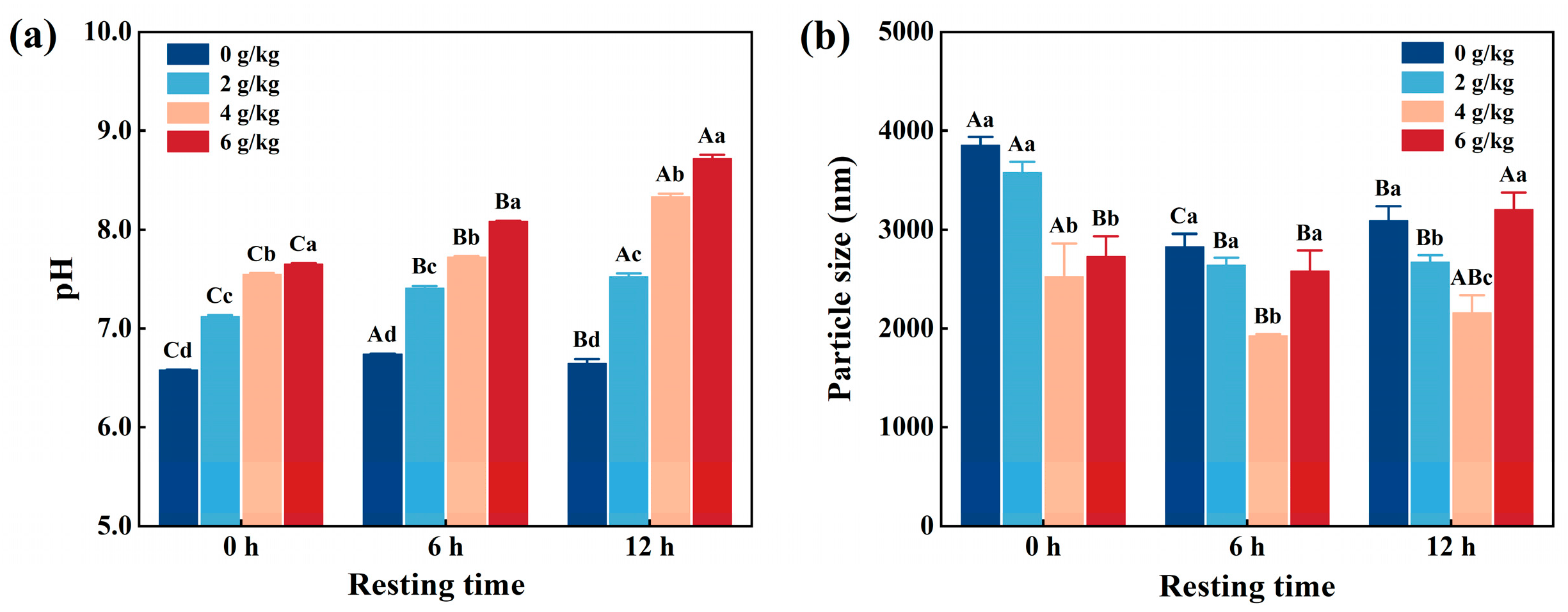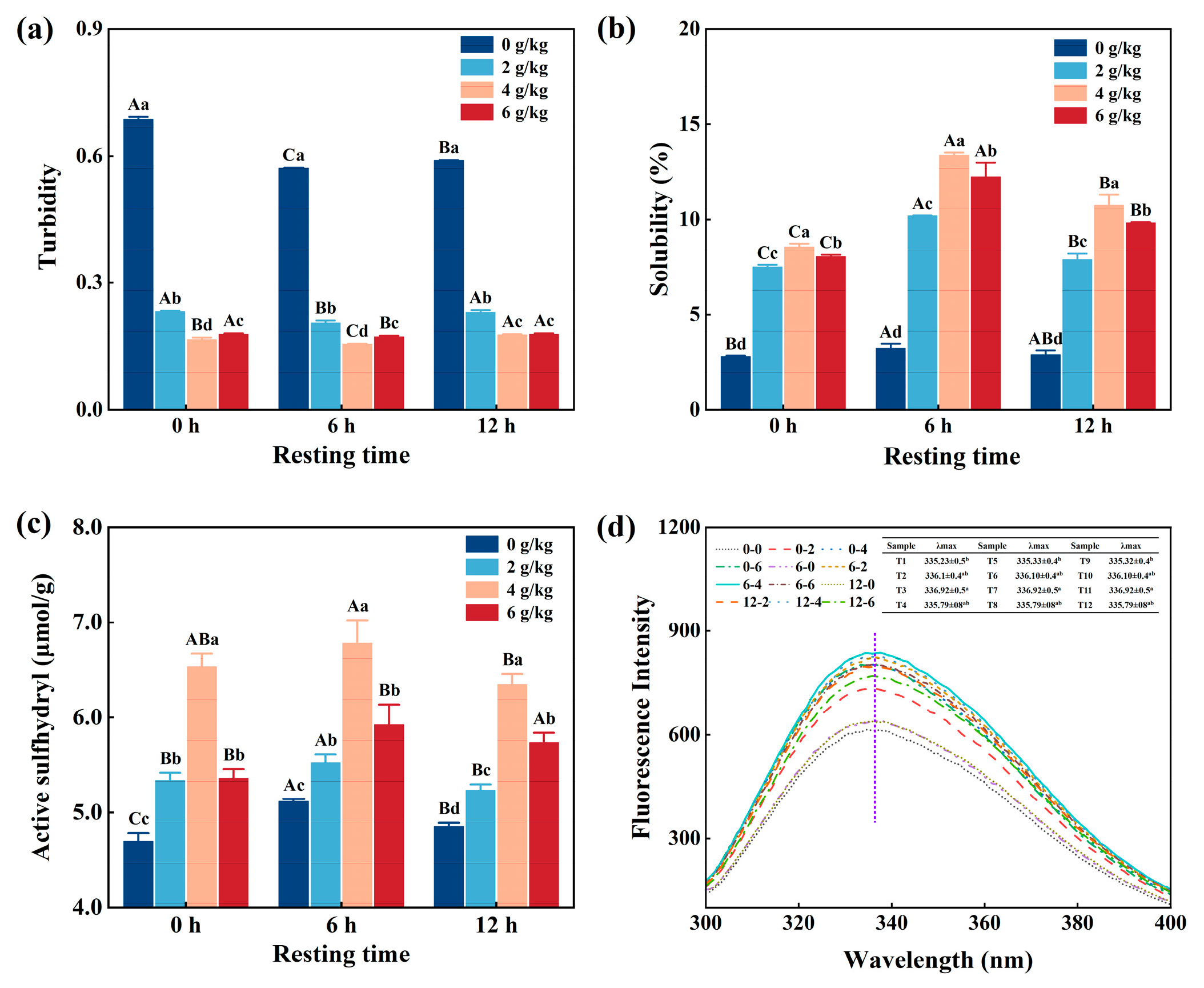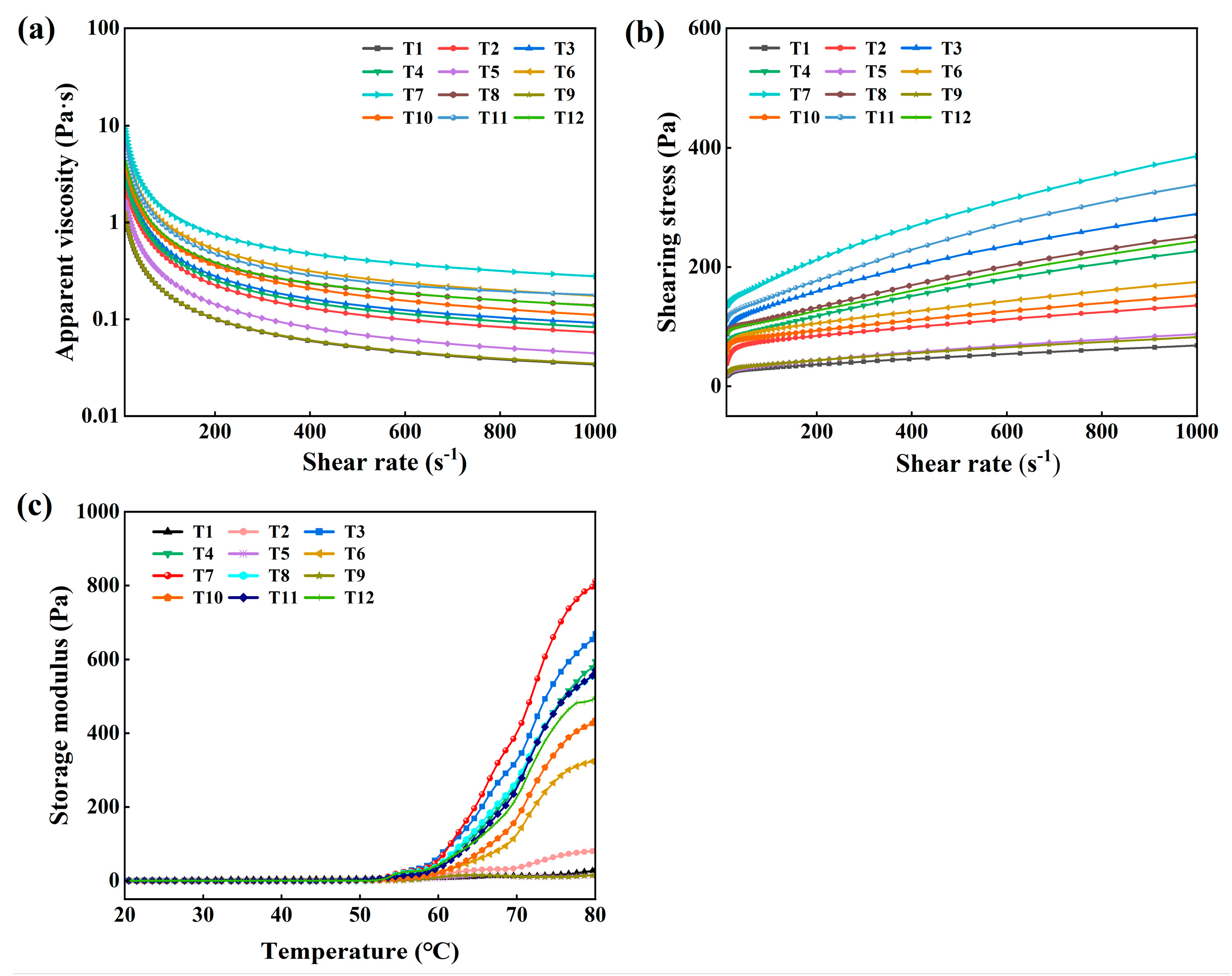Combined Effect of Resting Time and NaHCO3 on Solubility and Gel Properties of Low-Salt Chicken Myofibrillar Protein
Abstract
1. Introduction
2. Materials and Methods
2.1. Materials and Ingredients
2.2. Extraction of Chicken Myofibrillar Protein (CMP)
2.3. The Preparation of CMP Solutions and Gels
2.4. Determination of pH
2.5. Determination of Particle Size
2.6. Determination of Turbidity
2.7. Determination of Solubility
2.8. Determination of Active Sulfhydryl Groups
2.9. Determination of Fluorescence Properties
2.10. Determination of Apparent Viscosity and Shear Stress
2.11. Determination of Rheological Property
2.12. Determination of Whiteness
2.13. Determination of Texture
2.14. Statistical Analysis
3. Results and Discussion
3.1. pH
3.2. Particle Size
3.3. Turbidity
3.4. Solubility
3.5. Active Sulfhydryl Groups
3.6. Fluorescence Properties
3.7. Apparent Viscosity and Shear Stress
3.8. Rheology
3.9. Whiteness
3.10. Texture Properties
4. Conclusions
Author Contributions
Funding
Institutional Review Board Statement
Informed Consent Statement
Data Availability Statement
Conflicts of Interest
References
- Pretorius, B.; Schönfeldt, H.C. The contribution of processed pork meat products to total salt intake in the diet. Food Chem. 2018, 238, 139–145. [Google Scholar] [CrossRef]
- Zhang, W.; Naveena, B.M.; Jo, C.; Sakata, R.; Zhou, G.; Banerjee, R.; Nishiumi, T. Technological demands of meat processing–An Asian perspective. Meat Sci. 2017, 132, 35–44. [Google Scholar] [CrossRef] [PubMed]
- Zou, X.L.; Kang, Z.L.; Li, Y.P.; Ma, H.J. Effect of sodium bicarbonate on solubility, conformation and emulsion properties of pale, soft and exudative meat myofibrillar proteins. LWT-Food Sci. Technol. 2022, 157, 113097. [Google Scholar] [CrossRef]
- Xiong, G.; Fu, X.; Pan, D.; Qi, J.; Xu, X.; Jiang, X. Influence of ultrasound-assisted sodium bicarbonate marination on the curing efficiency of chicken breast meat. Ultrason. Sonochem. 2020, 60, 104808. [Google Scholar] [CrossRef]
- Kang, Z.L.; Shang, X.Y.; Li, Y.P.; Ma, H.J. Effect of Ultrasound-Assisted Sodium Bicarbonate Treatment on Aggregation and Conformation of Reduced-Salt Pork Myofibrillar Protein. Molecules 2022, 27, 7493. [Google Scholar] [CrossRef] [PubMed]
- Jiang, S.; Yang, C.; Bai, R.; Li, Z.; Zhang, L.; Chen, Y.; Ye, X.; Wang, S.; Jiang, H.; Ding, W. Modifying duck myofibrillar proteins using sodium bicarbonate under cold plasma treatment: Impact on the conformation, emulsification, and rheological properties. Food Hydrocoll. 2024, 150, 109682. [Google Scholar] [CrossRef]
- Hu, Y.; Zhang, L.; Yi, Y.; Solangi, I.; Zan, L.; Zhu, J. Effects of sodium hexametaphosphate, sodium tripolyphosphate and sodium pyrophosphate on the ultrastructure of beef myofibrillar proteins investigated with atomic force microscopy. Food Chem. 2021, 338, 128146. [Google Scholar] [CrossRef]
- Gao, R.; Wang, Y.; Mu, J.; Shi, T.; Yuan, L. Effect of L-histidine on the heat-induced aggregation of bighead carp (Aristichthys nobilis) myosin in low/high ionic strength solution. Food Hydrocoll. 2018, 75, 174–181. [Google Scholar] [CrossRef]
- Singh, A.; Buamard, N.; Zhou, A.; Benjakul, S. Effect of sodium bicarbonate on textural properties and acceptability of gel from unwashed Asian sea bass mince. J. Food Sci. Technol. 2022, 59, 3109–3119. [Google Scholar] [CrossRef]
- Shen, H.; Zhao, M.; Sun, W. Effect of pH on the interaction of porcine myofibrillar proteins with pyrazine compounds. Food Chem. 2019, 287, 93–99. [Google Scholar] [CrossRef]
- Bertram, H.C.; Meyer, R.L.; Wu, Z.; Zhou, X.; Andersen, H.J. Water distribution and microstructure in enhanced pork. J. Agric. Food Chem. 2008, 56, 7201–7207. [Google Scholar] [CrossRef] [PubMed]
- Zhu, D.Y.; Kang, Z.L.; Ma, H.J.; Xu, X.L.; Zhou, G.H. Effect of sodium chloride or sodium bicarbonate in the chicken batters: A physico-chemical and Raman spectroscopy study. Food Hydrocoll. 2018, 83, 222–228. [Google Scholar] [CrossRef]
- Kang, Z.L.; Yao, P.L.; Zhao, S.M.; Hou, Q.; Xu, J.G.; Ma, H.J. Effect of temperature and sodium bicarbonate combined on aggregation, rheology and conformation of low-salt chicken myofibrillar protein. LWT-Food Sci. Technol. 2024, 204, 116417. [Google Scholar] [CrossRef]
- Li, Y.P.; Zhang, X.H.; Lu, F.; Kang, Z.L. Effect of sodium bicarbonate and sodium chloride on aggregation and conformation of pork myofibrillar protein. Food Chem. 2021, 350, 129233. [Google Scholar] [CrossRef] [PubMed]
- Kang, Z.L.; Zhang, X.H.; Li, X.; Song, Z.J.; Ma, H.J.; Lu, F.; Zhu, M.; Zhao, S.; Wang, Z.R. The effects of sodium chloride on proteins aggregation, conformation and gel properties of pork myofibrillar protein Running Head: Relationship aggregation, conformation and gel properties. J. Food Sci. Technol. 2021, 58, 2258–2264. [Google Scholar] [CrossRef]
- Wang, W.; Pan, T.; Zhang, Y.; Wang, Y.; Zhu, J.; Zhang, D. Ultrastructure of longissimus dorsi myofibrillar proteins and heat-induced gels as observed with atomic force microscopy: Effects of pH values and sodium ions. Int. J. Food Prop. 2019, 22, 34–41. [Google Scholar] [CrossRef]
- Kang, Z.L.; Zhang, X.H.; Li, K.; Li, Y.P.; Lu, F.; Ma, H.J.; Song, Z.; Zhao, S.; Zhu, M.M. Effects of sodium bicarbonate on the gel properties, water distribution and mobility of low-salt pork batters. LWT-Food Sci. Technol. 2021, 139, 110567. [Google Scholar] [CrossRef]
- Bao, Y.; Boeren, S.; Ertbjerg, P. Myofibrillar protein oxidation affects filament charges, aggregation and water-holding. Meat Sci. 2018, 135, 102–108. [Google Scholar] [CrossRef]
- Lametsch, R.; Knudsen, J.C.; Ertbjerg, P.; Oksbjerg, N.; Therkildsen, M. Novel method for determination of myofibril fragmentation post-mortem. Meat Sci. 2007, 75, 719–724. [Google Scholar] [CrossRef]
- Mohan, A.; Jaico, T.; Kerr, W.; Singh, R. Functional properties of bicarbonates on physicochemical attributes of ground beef. LWT-Food Sci. Technol. 2016, 70, 333–341. [Google Scholar] [CrossRef]
- Wang, K.; Li, Y.; Zhang, Y.; Luo, X.; Sun, J. Improving myofibrillar proteins solubility and thermostability in low-ionic strength solution: A review. Meat Sci. 2022, 189, 108822. [Google Scholar] [CrossRef]
- Bertram, H.C.; Kristensen, M.; Andersen, H.J. Functionality of myofibrillar proteins as affected by pH, ionic strength and heat treatment—A low-field NMR study. Meat Sci. 2004, 68, 249–256. [Google Scholar] [CrossRef] [PubMed]
- Omana, D.A.; Plastow, G.; Betti, M. The use of β-glucan as a partial salt replacer in high pressure processed chicken breast meat. Food Chem. 2011, 129, 768–776. [Google Scholar] [CrossRef] [PubMed]
- Xi, J.; Li, Y. The effects of ultra-high-pressure treatments combined with heat treatments on the antigenicity and structure of soy glycinin. Int. J. Food Sci. Technol. 2021, 56, 5211–5219. [Google Scholar] [CrossRef]
- Garmyn, A.; Hardcastle, N.; Bendele, C.; Polkinghorne, R.; Miller, M. Exploring consumer palatability of Australian beef fajita meat enhanced with phosphate or sodium bicarbonate. Foods 2020, 9, 177. [Google Scholar] [CrossRef]
- Miriani, M.; Iametti, S.; Bonomi, F.; Corredig, M. Structural changes of soy proteins at the oil–water interface studied by fluorescence spectroscopy. Colloids Surf. B Biointerfaces 2012, 93, 41–48. [Google Scholar]
- Jin, J.; Ma, H.; Wang, K.; Yagoub, A.E.-G.A.; Owusu, J.; Qu, W.; He, R.; Zhou, C.; Ye, X. Effects of multi-frequency power ultrasound on the enzymolysis and structural characteristics of corn gluten meal. Ultrason. Sonochem. 2015, 24, 55–64. [Google Scholar] [CrossRef]
- Wu, F.; Shi, X.; Zou, H.; Zhang, T.; Dong, X.; Zhu, R.; Yu, C. Effects of high-pressure homogenization on physicochemical, rheological and emulsifying properties of myofibrillar protein. J. Food Eng. 2019, 263, 272–279. [Google Scholar] [CrossRef]
- Boutin, C.; Giroux, H.J.; Paquin, P.; Britten, M. Characterization and acid-induced gelation of butter oil emulsions produced from heated whey protein dispersions. Int. Dairy J. 2007, 17, 696–703. [Google Scholar] [CrossRef]
- Wang, Y.; Jiang, S.; Zhao, Y.; Zeng, M. Physicochemical and rheological changes of oyster (Crassostrea gigas) protein affected by high-pressure homogenization. LWT-Food Sci. Technol. 2020, 134, 110143. [Google Scholar] [CrossRef]
- Kang, Z.L.; Hou, Q.; Xu, J.G. Research Progress and Teaching Exploration of Physical Processing Technology for Reduced-Salt Gel Meat Products. Foods 2024, 13, 3606. [Google Scholar] [CrossRef] [PubMed]
- Zhang, Z.; Yang, Y.; Zhou, P.; Zhang, X.; Wang, J. Effects of high pressure modification on conformation and gelation properties of myofibrillar protein. Food Chem. 2017, 217, 678–686. [Google Scholar] [CrossRef]
- Li, J.; Munir, S.; Yu, X.; Yin, T.; You, J.; Liu, R.; Xiong, S.; Hu, Y. Double-crosslinked effect of TGase and EGCG on myofibrillar proteins gel based on physicochemical properties and molecular docking. Food Chem. 2020, 345, 128655. [Google Scholar] [CrossRef]
- Kang, Z.L.; Xie, J.J.; Li, Y.P.; Song, W.J.; Ma, H.J. Effects of pre-emulsified safflower oil with magnetic field modified soy 11S globulin on the gel, rheological, and sensory properties of reduced-animal fat pork batter. Meat Sci. 2023, 198, 109087. [Google Scholar] [CrossRef] [PubMed]
- Zhuang, X.; Zhang, W.; Liu, R.; Liu, Y.; Xing, L.; Han, M.; Kang, Z.; Xu, X.; Zhou, G. Improved gel functionality of myofibrillar proteins incorporation with sugarcane dietary fiber. Food Res. Int. 2017, 100, 586–594. [Google Scholar] [CrossRef]
- Petracci, M.; Laghi, L.; Rimini, S.; Rocculi, P.; Capozzi, F.; Cavani, C. Chicken breast meat marinated with increasing levels of sodium bicarbonate. J. Poult. Sci. 2014, 51, 206–212. [Google Scholar] [CrossRef]
- Li, F.; Wang, B.; Kong, B.; Shi, S.; Xia, X. Decreased gelling properties of protein in mirror carp (Cyprinus carpio) are due to protein aggregation and structure deterioration when subjected to freeze-thaw cycles. Food Hydrocoll. 2019, 97, 105223. [Google Scholar] [CrossRef]
- Kaewthong, P.; Wattanachant, C.; Wattanachant, S. Improving the quality of barbecued culled-dairy-goat meat by marination with plant juices and sodium bicarbonate. J. Food Sci. Technol. 2021, 58, 333–342. [Google Scholar] [CrossRef]
- Wu, Z.W.; Zou, X.L.; Yao, P.L.; Kang, Z.L.; Ma, H.J. Changes in Gel Characteristics, Rheological Properties, and Water Migration of PSE Meat Myofibrillar Proteins with Different Amounts of Sodium Bicarbonate. Molecules 2022, 27, 8853. [Google Scholar] [CrossRef]
- Wu, Z.W.; Shang, X.Y.; Hou, Q.; Xu, J.G.; Kang, Z.L.; Ma, H.J. Using ultrasonic-assisted sodium bicarbonate treatment to improve the gel and rheological properties of reduced-salt pork myofibrillar protein. Meat Sci. 2024, 212, 109465. [Google Scholar] [CrossRef]




| Samples | Hardness (g) | Springiness | Cohesiveness |
|---|---|---|---|
| T1 | 22.08 ± 0.79 e | 0.79 ± 0.06 d | 0.42 ± 0.02 e |
| T2 | 94.98 ± 3.81 c | 0.92 ± 0.01 c | 0.52 ± 0.06 d |
| T3 | 160.83 ± 20.55 a | 0.96 ± 0.00 b | 0.75 ± 0.02 a |
| T4 | 109.67 ± 30.20 bc | 0.94 ± 0.01 b | 0.75 ± 0.02 a |
| T5 | 49.69 ± 3.35 d | 0.73 ± 0.03 d | 0.44 ± 0.02 e |
| T6 | 134.18 ± 6.06 b | 0.95 ± 0.02 b | 0.73 ± 0.02 b |
| T7 | 187.14 ± 5.69 a | 0.99 ± 0.01 a | 0.77 ± 0.01 a |
| T8 | 121.76 ± 7.88 b | 0.96 ± 0.01 b | 0.74 ± 0.04 ab |
| T9 | 20.79 ± 2.39 e | 0.66 ± 0.01 e | 0.48 ± 0.01 d |
| T10 | 108.10 ± 18.35 c | 0.94 ± 0.03 b | 0.67 ± 0.04 c |
| T11 | 127.44 ± 24.25 bc | 0.95 ± 0.01 b | 0.77 ± 0.01 a |
| T12 | 111.74 ± 17.80 b | 0.95 ± 0.01 b | 0.72 ± 0.04 ab |
Disclaimer/Publisher’s Note: The statements, opinions and data contained in all publications are solely those of the individual author(s) and contributor(s) and not of MDPI and/or the editor(s). MDPI and/or the editor(s) disclaim responsibility for any injury to people or property resulting from any ideas, methods, instructions or products referred to in the content. |
© 2025 by the authors. Licensee MDPI, Basel, Switzerland. This article is an open access article distributed under the terms and conditions of the Creative Commons Attribution (CC BY) license (https://creativecommons.org/licenses/by/4.0/).
Share and Cite
Cheng, W.-L.; Yao, P.-L.; Zhang, X.-H.; Zhao, Y.-Y.; Zhao, S.-M.; Kang, Z.-L. Combined Effect of Resting Time and NaHCO3 on Solubility and Gel Properties of Low-Salt Chicken Myofibrillar Protein. Foods 2025, 14, 2121. https://doi.org/10.3390/foods14122121
Cheng W-L, Yao P-L, Zhang X-H, Zhao Y-Y, Zhao S-M, Kang Z-L. Combined Effect of Resting Time and NaHCO3 on Solubility and Gel Properties of Low-Salt Chicken Myofibrillar Protein. Foods. 2025; 14(12):2121. https://doi.org/10.3390/foods14122121
Chicago/Turabian StyleCheng, Wan-Li, Peng-Lei Yao, Xue-Hua Zhang, Yan-Yan Zhao, Sheng-Ming Zhao, and Zhuang-Li Kang. 2025. "Combined Effect of Resting Time and NaHCO3 on Solubility and Gel Properties of Low-Salt Chicken Myofibrillar Protein" Foods 14, no. 12: 2121. https://doi.org/10.3390/foods14122121
APA StyleCheng, W.-L., Yao, P.-L., Zhang, X.-H., Zhao, Y.-Y., Zhao, S.-M., & Kang, Z.-L. (2025). Combined Effect of Resting Time and NaHCO3 on Solubility and Gel Properties of Low-Salt Chicken Myofibrillar Protein. Foods, 14(12), 2121. https://doi.org/10.3390/foods14122121






